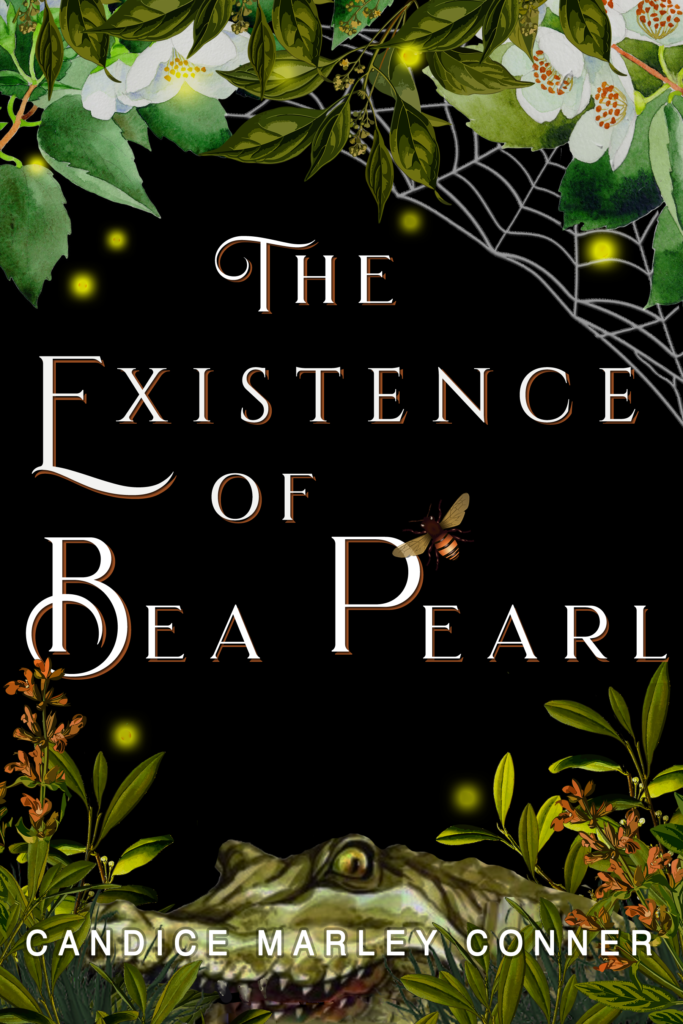For Example… Candice Marley Conner on Atmospheric Setting

A note about the series: “For Example…” is a series of blog posts intended to teach readers about one particular aspect of writing. Each week, a published writer will guest post about a topic of their choosing and use only their own work as the examples for their post. If you would like to be included in this series, please contact Kelly Ann Jacobson via this site or social media.
When I was in high school, my dad’s best friend told me about a series of novellas featuring a river monster who lived in a big house on the levee, swam in the river, whose family members danced in a hall, but if the boys got too rowdy, the monsters might just eat them (spoiler, they did). Best part, it was my river, the one just behind my parent’s house, and the dance hall—now a fish hatchery—was where I played and worked.
The book was Michael McDowell’s (Bettlejuice, Nightmare Before Christmas) family saga, Blackwater.
I couldn’t find all the books in our local library and they were out of print until last year when I finally finished all six novellas—twenty-two years later.
I fell in love with the Caskey family and their mysterious river matriarch, Elinor. But most of all, I felt a connection to the setting. I mean, how often can you read a passage and have it perfectly describe your home?
“Brave men unafraid of the alligators in the lake took their nervous girlfriends for rides in small boats…the dancehall was large, rectangular, and constructed entirely out over the water, with a gangway providing access from the land…Outside, on the other side of the picnic area, were a concession stand, two small bath houses, and a large swimming pool.” –Blackwater, “The War”
“An artesian-fed swimming pool sits alongside the concession stand…People swim in the pool but avoid the lake because of alligators…Lake George Restaurant is built over the water with a dance floor made of beautiful golden pine planks. Its walls are lined with windows so customers can watch fish jump as they eat fried bream or grilled catfish…”—The Existence of Bea Pearl
Through Blackwater’s example, I learned how to wrap the familiar into the atmospheric, to use setting as a character unto itself.
Setting can drive the tone and tension of the story just as much as the walking, talking characters. It’s usually the first thing that comes to me when I’m writing. Then the characters, and after much angst and gnashing of teeth, the plot.
Setting is two of the Five W’s: where and when. Place and time. It’s an element of literature that is introduced at the beginning of the story. Setting may be comprised of physical location, climate, cultural surroundings, time of day, time of year, or time period.
The reader needs to know at least one aspect of when and where the story happens to be able to fall into the story’s spell. Otherwise, without that rootedness, the reader can feel unconnected. Grounding the reader helps give the story context. To what degree used depends on genre as a science fiction or fantasy story needs more world-building in the beginning than a contemporary, well-known setting.
Here is the opening sentence that perfectly sets the scene for Blackwater:
“At dawn on Easter Sunday morning, 1919, the cloudless sky over Perdido, Alabama, was a pale translucent pink not reflected in the black waters that for the past week had entirely flooded the town.”
McDowell succinctly gives the reader the time of day, time of year, the year itself, a physical location, and the climate—a flooded town. He also incorporates eeriness into the sentence with a river where it’s not supposed to be, absorbing rather than reflecting the sky as water usually does. Already the reader senses that natural things won’t be behaving normally.
Here are the opening lines from The Existence of Bea Pearl that use setting descriptions to show the character we’re about to be introduced to:
“We are a murder of grounded crows, shrouded as we are in our black. The raw, red clay rectangle in the ground fills my vision, shoving out every other color besides shades of shadow.”
Let’s look at the clues: red clay, we’re near a river (physical location); a rectangle in the ground, a funeral (cultural surrounding). We don’t know the character yet but seeing what she sees, a shadowy world with only the rawness of red, we can guess she’s grieving. Just from the setting, we’re given a little glimpse into her emotional state. And that’s what you want—every description to be intentional so that the setting shows just as much as the characters and storyline. You want all the W’s working together to create a tight story.
How do you create mood and tension using setting? Let your character use their five senses. What does your character see? Hear? Taste? Smell? Touch? What your character notices about the world around them says a lot about their personality. This helps them become more fully-formed and relatable to the reader. Zooming into the details of the setting and having a relatable protagonist means your reader will have a hard time putting down your book. At least, that’s the goal—to make your novel un-put-downable.
In this excerpt, I use my main character’s senses to create mood and tension.
“The sandy cliffs tower over my head like a swamp cathedral, then open up as the creek empties into the river…The river flows over the limestone shelf until it spills down the eroded holes. I peer into a hole but only see a rush of silvery water… My memory of that March event seeps coldness into my soul. Fear lingers…pulling me down into the dark void.”
Bea Pearl is flashing back to the day she almost drowned in a flood surge and the last time she saw her brother alive. I use her sense of sight (lay of the land), touch (coldness), and hearing (river water pouring down limestone holes) to illustrate and weave together her memories and emotions (fear). This immersion of the senses hopefully draws the reader more fully into the heart of the story.
If you have a scene in your story that feels flat, have your character use their senses to observe the setting in more detail, though make sure it’s intentional to the tone and tension of your story to deepen the reading experience.
A good way to further study this by example is to pick up your favorite book and type out the first scene. Highlight the where, when, and senses to see how setting balances with the rest of the story. Two upcoming YA novels that do atmosphere awesomely are Erica Waters’ witchy contemporary fantasy, The River Has Teeth and Lyndall Clipstone’s lush gothic, Lakesedge.
About the Book:
Sixteen-year-old Bea Pearl knows her brother isn’t dead. Even if her parents don’t agree. Even if the entire town doesn’t believe her. She knows it’s true. When orders came to evacuate Lake George due to rising floodwaters, Bea Pearl saw Jim head toward the river. She followed him. Only she returned.
Bea Pearl’s insistence that Jim is alive and her quest to figure out what happened takes a toll on her shattering family. But she must unearth the truth surrounding her presumed dead brother. Otherwise, the rumors are true and she has killed him. Because if Jim can stop existing, could she too?
Author Biography:
Candice Marley Conner loves swampy settings and lives with her husband, two children, a guinea pig, and two cats in Alabama. The kidlit haint at a haunted indie bookstore and a Local Liaison for SCBWI, Candice is represented by the Jill Grinberg Literary Management. She is the author of the YA Southern mystery, The Existence of Bea Pearl, a dyslexic inclusive picture book, Sassafras and her Teeny Tiny Tail, and her work is found in Highlights Hello, Smarty Pants Magazine for Kids, Babybug Magazine and in collections such as Mardi Gras Pieces: A Mobile Writers’ Guild Anthology, Chicken Soup for the Soul and Cabinet of Curiosities which contains a Bea Pearl short story that pays homage to Blackwater. You can find Candice at www.candicemarleyconner.com, www.instagram.com/candice_marleyconner, www.facebook.com/cmarleyconnerauthor, and www.twitter.com/candice_marleyc


Leave a Reply